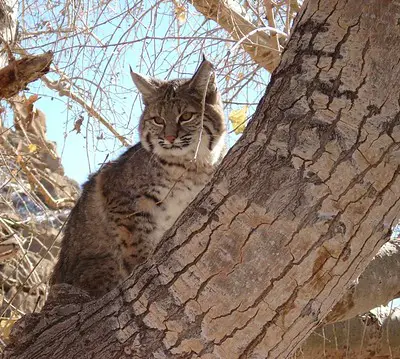Will you be hunting bobcats in Massachusetts this year? This article covers many of the fundamental laws you will need to know to get started. It also provides information such as seasons, harvest limits, and required permits for bobcat hunting in Massachusetts. It is not a legal document and is not intended to cover all hunting laws and regulations.

In Massachusetts, the bobcat hunting season runs from December 20, 2022, to March 8, 2023. A license is required. Bobcats may only be hunted in Zones 1-8. Hunting hours begin ½ hour before sunrise and end ½ hour after sunset. There are no bag limits.
Bobcat hunting season closed during the shotgun deer season.
Purchase a Massachusetts hunting license here.
Check out the Massachusetts hunting seasons.
If this is your first time hunting bobcats, these two articles will help you get started.
How to read bobcat tracks and scat.
Related: Read this article for the laws for hunting coyotes in Massachusetts.
Related: Read this article for the laws for hunting fox in Massachusetts.
General laws for hunting bobcats in Massachusetts.
Night hunting. Not permitted.
Electronic callers and decoys. All forms of predator calls are legal. Read this article and watch the video to learn how to use a closed reed rabbit squealer.
You can check Amazon for electronic predator caller prices here.
Decoys are legal. You can read about some highly effective but inexpensive ($20) coyotes decoys here.
Baiting. Baiting of bobcats is legal. Read my article on how to create the perfect bait pile.
Sunday hunting. Hunting is prohibited on Sundays.
Blaze orange. When hunting on a pheasant or quail stocked WMA during the pheasant/quail season, a blaze orange cap is required.
Legal implements for hunting bobcats in Massachusetts.
Shotguns: Only shot size up to #1 birdshot (pellet diameter equal to or less than 0.160 inches) can be used.
Archery equipment: Archery tackle is legal, with no minimum pull. Crossbows may only be used by permit. Poisoned arrows, explosive tips, and bows drawn by mechanical means are prohibited.
Rifles and handguns: There are no restrictions on caliber size for rifles or handguns.
Muzzleloaders: Smooth bore muzzleloaders: Only shot size up to #1 birdshot (pellet diameter equal to or less than 0.160 inches) can be used. Rifled bore muzzleloaders: no restrictions on caliber size.
Bobcats must tagged.
- Bobcats cannot be reported online. Report at an official furbearer check station.
- You must report your bobcat harvest within 4 working days of the end of the season.
- Seals must remain attached to the pelt/carcass until the pelt/carcass is prepared for mounting by a taxidermist or the pelt is sold or tanned.
Can I kill a property destroying bobcat on my property in Massachusetts?
Due to the complexity of the law, you should always contact your local game warden or animal control officer before taking any action.
You might want to reference General Law Part 1, Title XIX, Chapter 131, Section 37.
Section 37: Killing of game by owner or tenant of land; reports
Section 37. An owner or tenant of land or, if authorized by such owner or tenant, any member of his immediate family or his employee, as defined pursuant to section one of chapter sixty-two B, may, upon such land:—
(1) kill or attempt to kill, by means other than poisoning or trapping, any wild bird damaging his property, including domesticated animals, poultry and game on game-rearing farms or preserves, provided that such killing is not contrary to any federal law, rule or regulation.
(2) hunt or take by other means, except by poison or snare, any mammal which he finds damaging his property except grass growing on uncultivated land. No such owner or tenant shall authorize any person, other than a member of his immediate family or a person permanently employed by him, to place traps for the protection of said property other than during the open season, unless such owner or tenant has first obtained from the director a permit authorizing him so to do, which permit the director is hereby authorized to issue in his discretion, unless such authorized person holds a trapping license. All deer so killed shall be turned over to any environmental police officer and shall be disposed of by the director of law enforcement.
The following written reports shall be sent to the director by such owner or tenant acting under authority of this section:—(a) upon the taking of pheasant, ruffed grouse, hares or rabbits, or the wounding or killing of a deer, a report stating the time and place, kind and number of birds or mammals so taken, wounded or killed, within twenty-four hours of such taking, wounding or killing; (b) upon the taking of any other birds or mammals, a report on or before January thirty-first of each year, stating the number and kinds of birds or mammals taken under authority of this section during the previous year. This section shall not be construed to limit any other provisions of this chapter.

